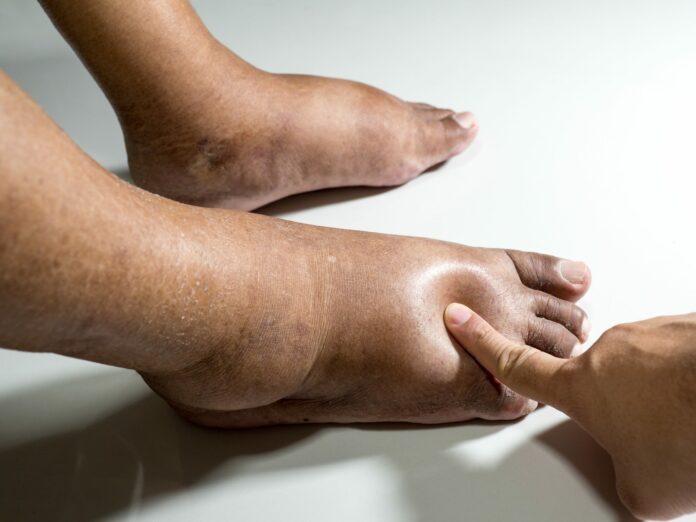This content material initially appeared on diaTribe. Republished with permission.
By John Carr
Charcot foot is an unusual, however critical diabetes complication. Probably the greatest methods to forestall it’s with easy routine foot care, akin to carrying well-fitting footwear and conserving toes clear.
Charcot neuropathic arthropathy, extra generally referred to as Charcot foot, is a diabetes-related complication that outcomes from injury to nerve fibers within the ankle and toes.
This complication can happen in individuals who develop nerve illness from diabetes (diabetic peripheral neuropathy). The lack of sensation within the extremities is attributable to long-standing elevated blood sugar from diabetes, which over time damages nerves.
A 2021 research from Denmark estimates that about 5 out of 1,000 sufferers being handled for diabetes had Charcot foot. Managing blood sugar and training each day foot care are two of the strongest techniques for stopping problems like Charcot foot.
What causes Charcot foot?
Nerves within the toes are significantly vulnerable to neuropathy for causes not properly understood. Nerve injury can result in the progressive destruction of foot and ankle buildings in numerous methods – one being Charcot foot.
Charcot foot usually begins with a easy harm or small an infection that goes unnoticed and untreated because of the lack of sensation from neuropathy. With out the traditional sensation of ache, folks will proceed an exercise and trigger additional harm, resulting in an more and more bigger inflammatory response.
Finally, the inflammatory response begins to destroy surrounding tissues, together with bone, ligaments, tendons, muscle tissue, small blood vessels, and different nerves. Compromise of those structural components within the foot leads to issues over time if left untreated, together with foot ulcers.
Dr. Clayton Bettin, an orthopedic and foot surgeon in Memphis, describes how these accidents usually happen.
“In an individual with peripheral neuropathy from diabetes, the small corrections which might be crucial throughout strolling aren’t there and what that results in is plenty of little traumas over time. That results in the destruction of those joints,” Bettin defined.
“These joints grow to be unstable, and identical to a straw that breaks the camel’s again, there may be an occasion, and the entire joint turns into dislocated. Usually that may be terribly painful, however our sufferers with neuropathy simply don’t know,” he stated.
Learn how to acknowledge Charcot foot
It’s essential to acknowledge indicators and signs of diabetic neuropathy early earlier than power accidents and irritation deform the form of the toes or toes and result in Charcot foot.
Indicators and signs of peripheral neuropathy embrace:
- Numbness or tingling within the toes
- A burning sensation within the affected areas, particularly at night time time
- Lack of hair and discoloration of the pores and skin or nails
Routine foot care with a podiatrist (foot specialist) is a important element of excellent diabetes care. It’s the only most essential factor you are able to do to determine the small or refined adjustments that assist with early prognosis; easy issues, like problem discovering footwear that match.
Early phases of Charcot foot embrace:
- Discoloration or redness
- Swelling
- Foot ache
- A sense of warmth or heat (particularly one foot noticeably hotter than the opposite)
By the point foot deformity seems, important injury to the joint is current. How Charcot foot is handled depends upon the severity of the foot deformity. A prognosis and evaluation of Charcot foot begins with a bodily examination and lab testing and should embrace imaging akin to X-rays or an MRI.
Latest surveys have reported that almost all of physicians and healthcare suppliers are unaware of diagnose and deal with Charcot foot and depend on specialists like orthopedic surgeons and podiatrists to deal with this complication. Consequently, charges of late prognosis and misdiagnosis are excessive.
Treating Charcot foot
Step one is to cease any ongoing injury, which suggests treating an an infection or ulcer with the suitable medication, and pausing any actions exacerbating the issue.
An an infection could require antibiotics, extra testing, session with different medical specialists, hospitalization, and in extreme instances, surgical procedure. Units like a solid, crutches, walker, or wheelchair could also be used to assist alleviate and utterly offload the foot so therapeutic can happen.
In extreme instances that require surgical procedure, the last word objective is restoring the flexibility to stroll with out assistive gadgets, stated Dr. Dane Wukich, professor and chair of orthopedic surgical procedure on the College of Texas Southwestern Medical Heart.
“As a result of these sufferers usually have an underlying illness, akin to heart problems, strolling and exercise can actually assist with lowering mortality,” Wukich stated.
Learn how to stop Charcot foot
Within the case of Charcot foot, the most effective therapy is prevention. Stopping neuropathy is essential; in case you don’t have neuropathy, you received’t develop Charcot foot.
If you have already got neuropathy, stopping its development will assist stop Charcot foot. In case you have neuropathy that has progressed, Bettin explains why recognizing Charcot foot early is so important.
“In case you have Charcot, you’ve gotten a ten% likelihood of amputation in your lifetime. For those who add an ulcer to that, your threat goes as much as 50%,” Bettin stated.
Easy routine foot care is probably the most highly effective option to stop Charcot foot, which incorporates:
- Examine your toes and toes each day for pink or uncooked areas of pores and skin
- Monitor and report adjustments to your toes to a doctor or podiatrist
- Make sure that footwear present help and suit you correctly; ensure there is no such thing as a rubbing or tight spots (customized footwear or shoe inserts could assist)
- Hold footwear and toes dry
- Care in your pores and skin and nails each day

